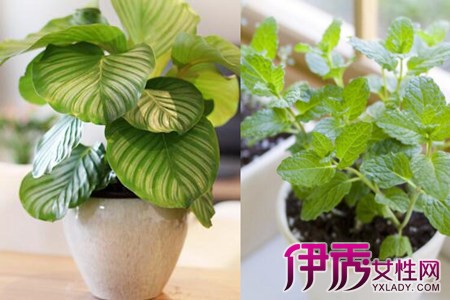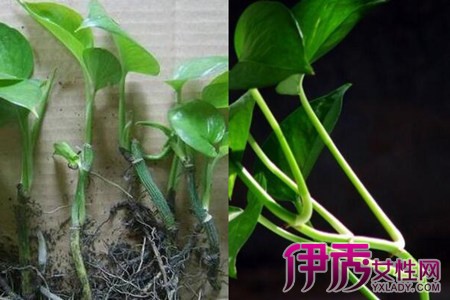The maintenance methods of potted plants can only be more flexible by mastering skills.

For the cultivation of potted plants, the first thing is to find a suitable flowerpot, because the small plants are very beautiful on the table. So when choosing a flowerpot, it is more delicate and beautiful to use that kind of small porcelain pot, but the bottom of the flowerpot must have a hole. In this way, flowerpots with holes can be more breathable, which is of great help to the growth of flowers.
After choosing a suitable flowerpot, you have to find a suitable flower soil. Many people think that you can grow flowers by casually getting some soil. This idea is completely wrong, when breeding potted plants, we must choose soft soil, so that the soil can help plants to take root without being affected, in order to better grow.
Plants that have just been planted must be well watered, and many people think they can be wet. In this way, the soil inside is dry and the flower roots can not take root, so it will be difficult to survive, so watering should be sufficient to make the flowers grow better. Otherwise, there will be blackening of the roots, or even decay in serious cases.
Be sure to master the temperature. Many people will put the planted plants outdoors. In this way, when the leaves are exposed to the sun, the leaves will be yellowed, and some plants will be red, so it is difficult to return to the normal color, so the newly planted plants are more suitable for growth indoors. It grows faster in an indoor ventilated place.
In winter, many people will put the plants on the edge of the indoor heating, think that this can be more warm. In fact, plants can grow normally as long as they are kept at about 18 degrees, so don't always bake on the edge of the radiator, which will affect the normal growth.
Which plants can be hydroponically cultured? Introduction of green plant varieties that can be cultured in water
Green plants are becoming more and more popular, many people raise green plants, like hydroponic green plants, hydroponic green plants maintenance is relatively simple, but also can see the white roots of green plants, it looks very clean and fresh. So which plants can be hydroponically cultured? Let's learn about several kinds together.
1. Tongqian grass
Rabdosia angustifolia is a very suitable hydroponic plant, the hydroponic plant leaves grow very watery, green leaves can also grow yellowish green flowers. Copper grass can also be cultivated in soil, but it needs to be watered frequently, but it needs to be watered frequently, but in hydroponic culture, it is not necessary to water so often, just add water when there is little water.
two。 Ivy
Ivy is also a popular green plant, which can not only decorate the home but also purify the air. It is the first choice for many newly decorated families. Hydroponic ivy grows very fast, and ivy can also take root through water. It is one of the green plants that are very easy to breed, and small potted plants are very delicate and elegant.
3. Green pineapple
The maintenance of green pineapple is also very extensive, especially when it is cultivated and protected by water, it only needs to add water at the right time, and occasionally add a little nutrient solution in the water, it can make the green pineapple rub and grow, and the green pineapple is more suitable for the maintenance of semi-overcast environment. Can not accept direct sunlight, otherwise it is easy to cause leaves to yellowing and dry.
4. Hanging orchid
Hanging orchid is the most common plant, it can be said to be the most common green plant at home, it is very suitable for hydroponic plants, only need to pick the seedlings with aerial roots into the water to be able to cuttage life, maintenance is also very simple, soil culture and protection is easy to grow burst basin, vitality is not generally exuberant.
The four kinds of plants introduced by the editor can be maintained by water culture. for plant cultivation, water culture is not easy to burst than soil culture, and simple, fresh and elegant water culture will make plants look petite and cute, deeply loved by many girls. Speaking of which, the editor would like to ask, do you prefer hydroponic culture or soil culture? What other hydroponic plants do you know? Welcome to leave a message to share.
How to raise calla lilies and the culture methods of calla lilies (the best from August to September)
In recent years, calla lilies can not only be used for flower appreciation, but also can purify the air, so many people want to raise calla lilies, so how much do you know about calla lilies? It is very important for beginners to understand the culture methods of calla lilies, so let the editor of Hua Yu net answer for you how to raise calla lilies and how to raise calla lilies.
Culture methods of calla lilies
Before we know how to raise calla lilies, let's take a look at the flowering period of calla lilies. The natural flowering period of calla lilies is from November to June of the following year, the whole flowering period is 6-7 months, and it is in the peak flowering season. Moreover, calla is an important cut flower at home and abroad, which has a wide range of uses, and calla also has the function of decomposing toxins and purifying air and improving mood. Next, let's learn the basic knowledge of calla lily culture.
1. The best time for breeding
Among the culture methods of calla lilies, the first thing to pay attention to is the best time for culture, and the most suitable season for calla lilies is from August to September in summer. Generally speaking, calla lilies will enter the dormant period from June to July, when you can take off the bulbs around mature plants to breed new potted plants, and separate plants must be propagated in autumn, otherwise it will be very difficult to blossom in that year, that is, flowering will be late.
2. Methods of reproduction
If we want to understand how calla lilies are raised, we must understand the breeding methods of calla lilies. The propagation method of calla lily is mainly divided ball propagation. After the plant enters the dormant period, peel off the small balls around the tuber and plant them separately. Of course, it can also be sowed and propagated, and the seeds can be sown in pots immediately after maturity, and the optimum temperature for germination is about 20 ℃.
It should be noted that cultivated calla lilies usually plant balls after autumn, take the plant out of the basin every September, break off the seed balls around the mother plant, smear the wound with plant ash to avoid infection and decay, change the sterilized culture soil, and then put the mother ball into 4000 times potassium permanganate solution, soak it for 15 to 20 minutes, and then put it in the pot according to the size of the ball, so that the plant will be the same size in the coming year. Bulbs need to be cultivated for 3 years before they can blossom. Ramet reproduction must be in autumn, otherwise it is very difficult to blossom in that year, that is, flowering, flowering is also late.
3. Environmental requirements
Calla lilies like warm climate, can not bear high temperature, can not bear cold, the suitable temperature for growth is about 20 ℃, when 0 ℃, the rhizome will be frozen to death. Therefore, we need sufficient sunshine during winter, lack of light, less flowers, a little shade; shade should be given proper shade when the summer temperature is high. Another point is that calla lilies like a humid environment, a little stagnant water does not affect growth, but is not resistant to drought.
Moreover, its dormancy period varies with different regions. When cultivated in the Yangtze River Basin and the north of China, it is appropriate to move into the greenhouse in winter, blossom in winter and spring, and dormancy in summer because of high temperature and drought; while in the subtropics which are not cold in winter and not dry and hot in summer, there is no dormancy throughout the year. Generally speaking, after watching the culture methods of calla lilies, you will think that calla lilies are very easy to raise plants and flowers.
4, soil requirements
In the question of how to raise calla lilies, the requirements of the soil also need to be paid attention to. When calla was cultured, sandy loam soil was used as the main soil, garden soil and rotten leaves were mixed with 1 beat 3 each, and then mixed with 1 big 5 organic fertilizer. Because the root system grows in the upper part of the sphere, the bottom of the basin soil should be covered with water-permeable slag or coarse-grained sand. With 1/3 of the garden soil and rotten leaves. And add a small amount of organic fertilizer.
5, lighting requirements
Calla lilies should pay great attention to light when they are in bloom. Calla lilies "prefer long light to strong light", especially in summer. Therefore, in the culture method of calla lilies, calla lilies are usually placed in places with plenty of light, and can be moved to a distance from the window in summer. If the horseshoe lotus is not bright enough during the flowering period, it will only bud but not blossom, and even the bud will gradually turn green and shriveled. There is no need to shade the sun in spring and autumn.
6. Pest control
The prevention and control of diseases and insect pests is also a problem that we need to pay attention to when we understand how to raise calla lilies. The main disease harming the pedicel and leaf of horseshoe lotus is Botrytis cinerea, which can be sprayed with 500 × 800 times 50% carbendazim or 600 × 800 times 75% chlorothalonil diluent. The two drugs can be applied alternately and at intervals. Taro mosaic virus should also be prevented. The leaves of plants infected with taro mosaic virus are mosaic-like, shrinking, deformed and curled. It is found that the diseased plant should be pulled out and buried or burned immediately, and should never be propagated with this kind of plant tuber.
7. Water-fed calla lilies
In the culture method of calla lilies, we can also choose to raise calla lilies in water. The method is to place the potted calla lotus plants that have been pregnant in a shallow porcelain plate slightly larger than the bottom diameter of the flowerpot, and then look at the plate with water about 0.5 cm deep. In daily life, the potted soil is mainly watered to keep the potted soil moist. When the temperature rises to about 15 ℃, the flower bud enters the rapid growth period, and flake or granular compound fertilizer without irritating odor can be applied to the basin soil to promote plant growth and bud expansion.
In this way, during the flowering period, the plant not only has enough nutrition, but also the plant is always in a relatively humid environment, which can ensure that its leaves are watery, the bud is crystal clear, and can sprout more progeny. Raising calla lilies in shallow water can not only avoid the worry of soiling the table when potted soil is watered, but also not affect the growth of potted flowers when there is no one to take care of them for a short time.
Matters needing attention in calla lily culture
1. Pay attention to watering
Calla lilies like to be wet and fat, and should not be short of water from the beginning of budding. it is appropriate to water once a day to keep the basin soil often moist. But watering can not make the basin soil too wet, otherwise it is easy to cause tuber rot, especially in the dormant period basin soil must avoid stagnant water.
2. Avoid dampness in the heart of leaves.
Calla lilies avoid wet leaves, usually watering accidentally make water droplets flow into the leaves will cause soft rot.
3. Small methods of fertilization
Fertilizer should be applied from the edge of the basin, and the fertilizer should not be drenched into the petiole or leaf center, otherwise it will also cause yellow leaves or rot. After budding, it is appropriate to apply liquid fertilizer based on phosphate fertilizer, which will make the flower color more pure. Water should be irrigated once the next day after fertilization and loosen the soil in time.
4. The method of preserving tuber
The flowering period of calla lily is from February to April, and the watering stops gradually after flowering; after May, the plant begins to wither and yellow, so it should be ventilated and kept dry to prevent tuber from rotting. When the plant is completely dormant, the tubers can be taken out, dried and stored, and then planted in autumn.
5. Pay attention to the cleanliness of the leaf surface
Calla lilies like to have plenty of water during their growth, so they should often sprinkle water on the leaves and the ground, and pay attention to the cleanliness of the leaves.
6. Pay attention to daylighting and shelter from rain
In order to avoid the influence of leaves on daylighting during maintenance, the outer leaves can be removed, which is also conducive to pedicel protruding. If it is maintained outdoors, rain-shielding cultivation facilities must be used to prevent rain and reduce the quality of flowers.
- Prev

Learn how to cut green pineapple to make yourself a professional florist.
This kind of flower is not only pleasing to the eye, but also can remove harmful gases from the room. So raising more pots of green pineapple is very good for the health of the family, but if you want to raise more, you can't always buy it, so today we're going to tell you how to breed green pineapple.
- Next

It is not difficult to know the characteristics and growth habits of eight Immortals and to cultivate flowers and plants.
The eight Immortals are very beautiful and have a lot of fragrance. Many people like to breed them at home. However, many people do not have a good grasp of the characteristics of the culture of the eight Immortals. In fact, it is not difficult to master the habit of breeding the eight Immortals.
Related
- Fuxing push coffee new agricultural production and marketing class: lack of small-scale processing plants
- Jujube rice field leisure farm deep ploughing Yilan for five years to create a space for organic food and play
- Nongyu Farm-A trial of organic papaya for brave women with advanced technology
- Four points for attention in the prevention and control of diseases and insect pests of edible fungi
- How to add nutrient solution to Edible Fungi
- Is there any good way to control edible fungus mites?
- Open Inoculation Technology of Edible Fungi
- Is there any clever way to use fertilizer for edible fungus in winter?
- What agents are used to kill the pathogens of edible fungi in the mushroom shed?
- Rapid drying of Edible Fungi

